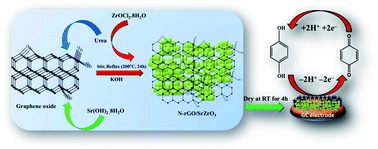当前位置:
X-MOL 学术
›
Nanoscale Adv.
›
论文详情
Our official English website, www.x-mol.net, welcomes your feedback! (Note: you will need to create a separate account there.)
A highly sensitive and selective hydroquinone sensor based on a newly designed N-rGO/SrZrO3 composite
Nanoscale Advances ( IF 4.7 ) Pub Date : 2019/12/09 , DOI: 10.1039/c9na00573k Khursheed Ahmad 1 , Praveen Kumar 1 , Shaikh M Mobin 1, 2, 3
Nanoscale Advances ( IF 4.7 ) Pub Date : 2019/12/09 , DOI: 10.1039/c9na00573k Khursheed Ahmad 1 , Praveen Kumar 1 , Shaikh M Mobin 1, 2, 3
Affiliation

|
Herein, we have reported a novel composite of nitrogen doped reduced graphene oxide (N-rGO) and strontium zirconate (SrZrO3). This new composite (N-rGO/SrZrO3) was synthesized using the reflux method. The physicochemical properties of N-rGO/SrZrO3 were determined using different advanced techniques such XRD, FE-SEM, EDX, FTIR and BET. Furthermore, a glassy carbon electrode was modified with N-rGO/SrZrO3 (GCE-2). This modified electrode was employed for the sensing of HQ. The electrochemically active surface area (ECSA) of this modified electrode (GCE-2) was calculated by employing the Randles–Sevcik equation. Furthermore, GCE-2 exhibited a good detection limit (0.61 μM) including high selectivity towards HQ.
中文翻译:

基于新设计的 N-rGO/SrZrO3 复合材料的高灵敏度和选择性对苯二酚传感器
在此,我们报道了氮掺杂还原氧化石墨烯(N-rGO)和锆酸锶(SrZrO 3)的新型复合材料。这种新的复合材料(N-rGO/SrZrO 3)是使用回流法合成的。N-rGO/SrZrO 3的物理化学性质是使用不同的先进技术确定的,例如 XRD、FE-SEM、EDX、FTIR 和 BET。此外,用N-rGO/SrZrO 3 ( GCE-2 )对玻碳电极进行了改性。这种修饰电极被用于HQ的传感。该修饰电极 ( GCE-2 )的电化学活性表面积 (ECSA)采用 Randles-Sevcik 方程计算。此外,GCE-2表现出良好的检测限(0.61 μM),包括对 HQ 的高选择性。
更新日期:2020-02-13
中文翻译:

基于新设计的 N-rGO/SrZrO3 复合材料的高灵敏度和选择性对苯二酚传感器
在此,我们报道了氮掺杂还原氧化石墨烯(N-rGO)和锆酸锶(SrZrO 3)的新型复合材料。这种新的复合材料(N-rGO/SrZrO 3)是使用回流法合成的。N-rGO/SrZrO 3的物理化学性质是使用不同的先进技术确定的,例如 XRD、FE-SEM、EDX、FTIR 和 BET。此外,用N-rGO/SrZrO 3 ( GCE-2 )对玻碳电极进行了改性。这种修饰电极被用于HQ的传感。该修饰电极 ( GCE-2 )的电化学活性表面积 (ECSA)采用 Randles-Sevcik 方程计算。此外,GCE-2表现出良好的检测限(0.61 μM),包括对 HQ 的高选择性。



























 京公网安备 11010802027423号
京公网安备 11010802027423号